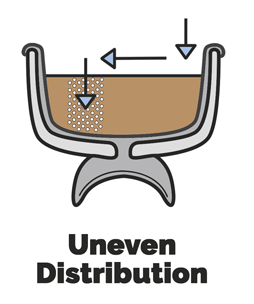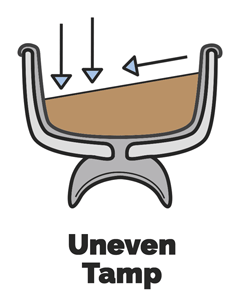Channelling
Understanding How to Identify Critical Unevenness in the Flow of Espresso
When channelling is taking place in a shot to such an extent that the flow appears visibly disturbed, then a shot is very likely ‘unservable’ and needs to be remade. Here are some examples of what we mean.
Water always follows the path of least resistance. It will travel more quickly through a region of a coffee bed that is less dense. If you make a mistake in your dosing, distributing or tamping, then channelling will occur. When it’s extreme, you can see channelling taking place. If you have a naked portafilter, you will notice a channel looks like a squirt of water that has a lighter and more watery appearance than it would have if the coffee was extracting properly. It looks more watery because it contains less dissolved coffee solids. With channelling, water that should have been shared equally across the whole coffee bed is drawn instead to this localised area. where it can travel more quickly through the coffee bed. The effect of this is a much weaker shot overall.
Even when you don’t have a naked portafilter, a strong channel will disrupt the ordinary flow of espresso so much that the espresso flowing out of each side of the spouts on your portafilter into the cup will look more turbulent and more transparent than in a well made shot. If you see this, you will need to remake the shot. The reason channelled shots aren’t servable is that they are weaker, more bitter, and less balanced than optimal shots.
Here are some typical causes of channelling.
- Uneven distribution

An area with less coffee in it will put up less resistance to the flow of water.
- Uneven tamping

- A poorly designed tamper base

Convex tamper bases that are curved on the base,